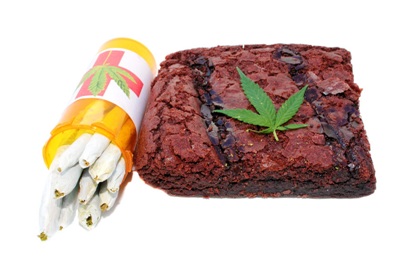
Candy, cupcakes, and chocolate cannabis edibles, yum! What could go wrong? Eating is better than smoking, no? When it comes to using cannabis, ingestion takes a different metabolic route than inhalation. So, just how do the effects of eating cannabis differ from smoking it?
Why people smoke marijuana

Smoking marijuana has been a cultural tradition for centuries. Smoke has long been part of rituals and ceremony as incense, burning wood, or herbal fragrance. Its lift to the sky has evoked and invoked thoughts of spiritual contacts.
But, many smoke without the spiritual context:
- Where socially or politically prohibited, smoking ganja protests restrictions on personal freedom to explore and discover realms of imagination.
- Victims of medical problems, like chronic pain, depression, spastic diseases, stress, and other disabling conditions, smoke marijuana to relieve symptoms. For some, marijuana has replaced prescription medications and pain killers.
- Some people use the psychoactive effects of marijuana to escape what they perceive as daily burdens. They seek the rest and mellow effects to reflect on their problems and balance their response.
- Creative people claim to find renewal and inspiration in being high. It expands their physical and cerebral experience to enable and inform their artistic work.
- People will smoke while under stress to relax and calmly assess their situation and problems.
- Others smoke because their peers are smoking, because it completes social bonding with people and friends who have similar interests.
- People who smoke cigarettes will smoke marijuana as an option or a complement to their existing habit.
Most people smoke weed because they just like turning on. It’s a personal party and a chance to let go.
The smoking mechanism
When you inhale marijuana smoke, the bloodstream quickly absorbs the key component THC (tetrahydrocannabinol) through the lungs. It dilates the blood vessels and increases the blood pressure as it races to the brain. The body naturally harbors endogenous cannabinoids and cannabinoid receptors.
When those systems are in balance, the person feels stable and comfortable physically and psychologically. These elements exist in the brain, connective tissues, glands, immune cells, and organs.
Both are found where physical systems intersect. It’s at this bridge where you see the connection between brain and body, where the impact on one system disrupts the balance of the other. With both body and brain always seeking balance, they welcome agents that will restore the imbalance when body and brain are under the stress of pain, disease, or distress.
THC restores that balance by prompting the human systems to generate more endocannabinoids. It’s that restoration that users perceive as bliss and high. For smokers, that effect hits early and lasts up to hours depending on the potency of the cannabis strain.
Why people ingest cannabis

Many people are opposed to smoking in general as a risk to the lungs and as generally socially unacceptable. Others with certain medical conditions or those under medical care cannot smoke.
- Some smokers will supplement their pleasure with edibles during breaks from the smoking.
- Chronically ill patients may have difficulty swallowing or may need to manage their intake with careful dosing.
- Users with chronic asthma or respiratory allergies can opt for ingestion as an alternative.
- Eating cannabis relieves users of the smoker’s debris, ashes, and odor.
- Cooking with cannabis can be more efficient and economic than purchasing strains and smoking supplies.
- Many people choose to raise their own cannabis as they would any kitchen herb, so they have a regular supply.
- Caregivers find edibles easier to administer and manage for patients suffering after effects of chemotherapy or spending their final days in hospice.
But, ingested cannabis works differently on the body and brain, and misuse threatens some problems.
The ingestion mechanism
When users ingest cannabis in the form of bake goods or hard candies, the experience of a high takes longer to click in. It may take some two hours for the THC to release into the bloodstream because of the digestive process that begins when the THC reaches the stomach.
THC is not water-soluble, so it metabolizes in the liver where only less than 20 percent of the cannabinoids released reach the bloodstream. So, the high induced comes on later and last longer than with smoking.
And, that presents the risk that users will misread the process and resort to heavier and more frequent doses in their consumption. The basic difficulty in measuring dosage and calculating results makes setting standards and safeguards difficult. Even if the state regulates content, the needs and reactions will vary from user to user.
The future of edibles
Chances are that the medical marijuana market alone – for baked goods, candies, lozenges, oils, powders, and tinctures - will create a demand for standardized ingredients, calculated dosage, and informative labels. That will not do away with homegrown and homemade edible products, but it will serve a market that seeks to consume cannabis responsibly.
Chances are that the market will invite an industry of cookbook writers, gastronomes, and commercial cooks. The size and diversity of the market will drive new food branding, processing, and packaging. And, manufacturers and distributors will launch B2B and B2C campaigns.
And Chances are that the can economy will imitate the growth, expansion, and success of other industrial sectors. The irony is that it may become the sort of institution against which the original tokers thought to rebel.
"Allbud.com is your comprehensive guide to recreational and medical marijuana dispensaries and strains where you could find nearby dispensaries with reviews and/or explore over 3,000 strains with photos, videos and reviews."
For more details checkout here :- https://www.allbud.com/learn/story/how-effects-eating-cannabis-differ-smoking-it
